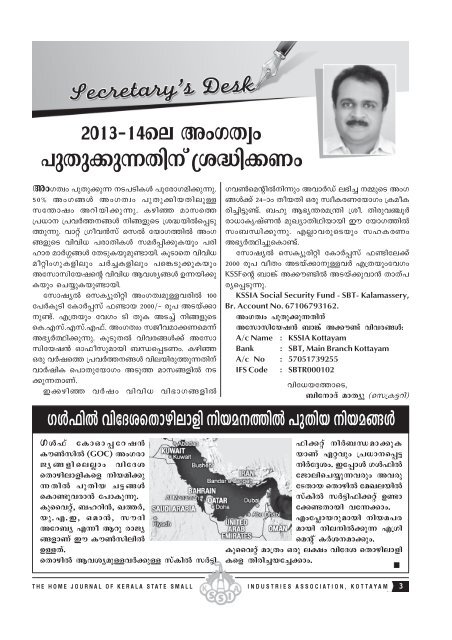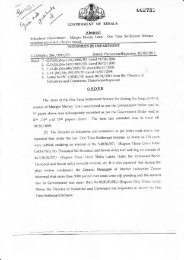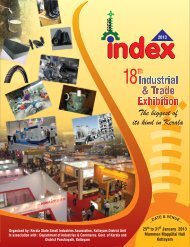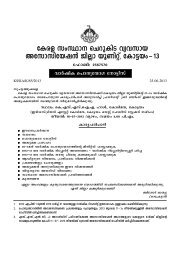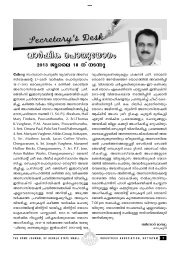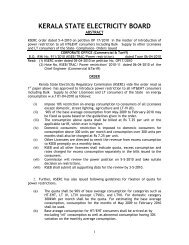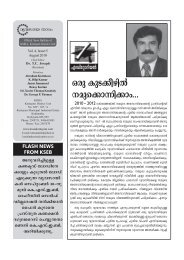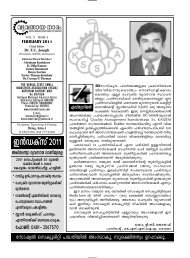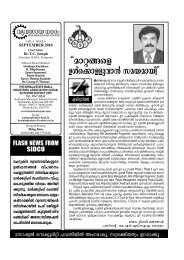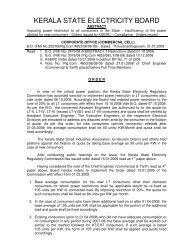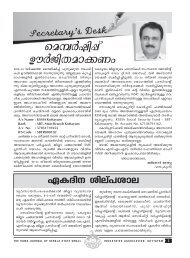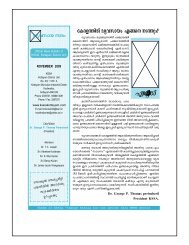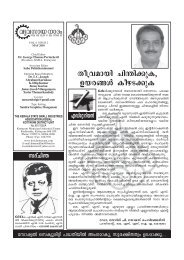Vyavasaya Nadham April 2013 - KSSIA Kottayam
Vyavasaya Nadham April 2013 - KSSIA Kottayam
Vyavasaya Nadham April 2013 - KSSIA Kottayam
Create successful ePaper yourself
Turn your PDF publications into a flip-book with our unique Google optimized e-Paper software.
<strong>2013</strong>-˛14se AwKXzw<br />
]pXp-°p-∂-Xn\v {i≤n-°-Ww<br />
AwKXzw ]pXp-°p∂ \S-]-Sn-Iƒ ]ptcm-K-an-°p-∂p.<br />
50% AwK߃ AwKXzw ]pXp°nbXnep≈<br />
kt¥mjw Adn-bn-°p-∂p. Ign amksØ<br />
{][m\ {]h¿Ø-\-߃ \nß-fpsS {i≤-bn¬s∏-Sp-<br />
Øp-∂p. hm‰v {Ko-h≥kv sk¬ tbmK-Øn¬ AwKß-fpsS<br />
hnhn[ ]cm-Xn-Iƒ ka¿∏n-°p-Ibpw ]cnlmc<br />
am¿§-߃ tXSp-I-bp-ap-≠m-bn. IqSmsX hnhn[<br />
ao‰nwKp-Ifnepw N¿®Ifnepw ]sSp°pIbpw<br />
Atkm-kn-tb-js‚ hnhn[ Bh-iy-߃ D∂-bn-°p-<br />
Ibpw sNøp-I-bp-≠m-bn.<br />
tkmjy¬ skIyq-cn‰n AwK-Xz-ap-≈-h-cn¬ 100<br />
t]¿IqSn tIm¿∏kv ^≠mb 2000/-˛ cq] AS-bv°m-<br />
\p-≠v. F{Xbpw thKw Sn XpI AS®v \nß-fpsS<br />
sI.-F-kv.-F-kv.F-^v.- AwKXzw kPo-h-am-°-W-sa∂v<br />
A`y¿∞n-°p-∂p. IqSp-X¬ hnhc߃°v Atkmkn-tb-j≥<br />
Hm^o-kp-ambn _‘-s∏-S-Ww. Ign<br />
Hcp h¿jsØ {]h¿Ø-\-߃ hne-bn-cp-Øp-∂-Xn\v<br />
hm¿jnI s]mXp-tbmKw ASpØ amk-ß-fn¬ \S-<br />
°p-∂XmWv.<br />
C°gn h¿jw hnhn[ hn`mKßfn¬<br />
Kh¨sa‚n¬\n∂pw Ahm¿Uv e`n® \ΩpsS AwKß-ƒ°v<br />
24-˛mw XobXn Hcp kzoI-c-W-tbmKw {Iao-Icn®n-´p-≠v.<br />
_lp B`y-¥ca{¥n {io. Xncp-h-©q¿<br />
cm[m-Ir-jvW≥ apJym-Xn-Yn-bmbn Cu tbmK-Øn¬<br />
kw_-‘n-°p-∂p. F√m-h-cp-sSbpw kl-I-cWw<br />
A`y¿∞n-®p-sIm≠v.<br />
tkmjy¬ skIyq-cn‰n tIm¿∏kv ^≠n-te°v<br />
2000 cq] hoXw AS-bv°m-\p-≈-h¿ F{X-bpw-thKw<br />
KSSFs‚ _mv A°u-≠n¬ AS-bv°p-hm≥ XmXv]-<br />
cys∏Sp∂p.<br />
<strong>KSSIA</strong> Social Security Fund - SBT- Kalamassery,<br />
Br. Account No. 67106793162.<br />
AwKXzw ]pXp-°p-∂-Xn\v<br />
Atkm-kn-tb-j≥ _mv A°u≠v hnh-c-߃:<br />
A/c Name : <strong>KSSIA</strong> <strong>Kottayam</strong><br />
Bank : SBT, Main Branch <strong>Kottayam</strong><br />
A/c No : 57051739255<br />
IFS Code : SBTR000102<br />
hnt[btØmsS,<br />
_nt\mZv amXyp (sk{I´dn)<br />
Kƒ^n¬ hntZ-i-sXm-gn-emfn \nb-a-\-Øn¬ ]pXnb \nb-a-߃<br />
Kƒ^v tImHm-∏-td-j≥<br />
Iu¨kn¬ (GOC) AwK-cm-<br />
Py-ß-fn-se√mw hntZi<br />
sXmgn-em-fn-Isf \nb-an-°p-<br />
∂-Xn¬ ]pXnb N´-߃<br />
sIm≠p-h-cm≥ t]mIp-∂p.<br />
Ipssh-‰v, _l-dn≥, JØ¿,<br />
bp.-F.-C, Ham≥, kuZn<br />
Atd_y F∂o Bdp cmPyß-fmWv<br />
Cu Iu¨knen-¬<br />
D≈-Xv.<br />
sXmgn¬ Bhiyap≈h¿°p≈ kvIn¬ k¿´n-<br />
^n-°‰v \n¿_-‘-am-°p-IbmWv<br />
G‰hpw {][m-\-s∏´<br />
\n¿t±-iw. Ct∏mƒ Kƒ^n¬<br />
tPmen-sN-øp-∂-hcpw Ah-cptS-Xmb<br />
sXmgn¬ taJ-e-bn¬<br />
kvIn¬ k¿´n-^n-°‰v D≠mt°≠Xmbn<br />
ht∂-°mw.<br />
Fwtπmb-dp-ambn \nb-a-]-cambn<br />
\ne-\n¬°p∂ F{Knsa‚<br />
v I¿i-\-am-°pw.<br />
Ipssh‰v am{Xw Hcp e£w hntZi sXmgnem-fn-<br />
Isf Xncn-®-b-t®-°mw.<br />
THE HOME JOURNAL OF KERALA STATE SMALL INDUSTRIES ASSOCIATION, KOTTAYAM 3
............................................................................................................................................<br />
hyhkmb\mZw<br />
G{]n¬ H∂v apX¬ hm‰v do^-≠n-\p≈ At]-£-<br />
Iƒ Hm¨sse-\mbn am{Xta ^b¬ sNøm-\mhq.<br />
tIcf hm‰v \nb-a-{]-Imcw aq∂p kμ¿`-ß-fn-emWv<br />
C≥]p´v SmIvkv do^-≠n\v A¿l-X-bp-≈-Xv. Ib-‰pa-Xn,<br />
A¥¿ kwÿm\ hn¬]\/ tÃmIv {Sm≥kv^¿,<br />
h¿jm-¥y-Ønse C≥]p´v SmIvkv s{IUn-‰v.<br />
Hcp amk-Øn¬ AS-bvt°≠ Hu´v]p´v SmIvknt\-°mƒ<br />
IqSp-X¬ C≥]p´v SmIvkv s{IUn‰v Ds≠-<br />
n¬ (tI{μ hn¬]\ \nIp-Xn-bn-te°p hI-h®<br />
tij-ap≈ _m°n s{IUn‰v ASpØ amk-Øn-te°v<br />
hI-bn-cp-Øm-sa-nepw) am¿®nse s{IUn‰v G{]n-ente°v<br />
hI-bn-cp-Øm≥ A\p-h-Zn-°n-√. 11(6) hIp∏v<br />
{]Imcw s{IUn-‰p≈ XpI do^≠v e`n-°m≥ N´w<br />
47 F A\p-k-cn®v t^mw 21 knkn-bn¬ Pq¨ 30<br />
\Iw do^≠v At]£ \¬I-Ww.<br />
Ib-‰p-a-Xn°v Hu´v]p´v SmIvkn-√. Ib-‰p-a-Xn-bpsS<br />
C≥]p´v SmIvkv do^-≠mbn e`n-°m≥ Ib-‰p-aXn<br />
\SØn Hcp h¿j-Øn-\p-≈n¬ N´w 47 A\p-k-cn®v<br />
t^mw 21 knbn¬ do^≠v At]£ \¬I-Ww. N´-<br />
{]-Imcw Ib-‰p-aXn sXfn-bn-°p∂ tcJ-Ifpw a‰pw<br />
At]-£-tbm-sSm∏w lmP-cm-°-Ww.<br />
A¥¿ kwÿm\ hn¬]-\-bpsS Imcy-Øn¬ do^-<br />
≠n-\mbn N´w 46 A\p-k-cn®v t^mw 21 _nbn-ep≈<br />
do^≠v At]£ knFkvSn AN´ amkm-¥y-Øn¬<br />
\n∂pw 30 Znh-k-Øn-\Iw ka¿∏n-°-Ww.<br />
A¥¿ kwÿm\ \o°w sXfn-bn-°p-∂-Xn-\p≈<br />
N´-{]-Im-c-ap≈ tcJ-Ifpw At]-£-tbm-sSm∏w<br />
\¬I-Ww. tÃmIv {Sm≥kv^-dns‚ Imcy-Øn¬ hmßnb-t∏mƒ<br />
5 iX-am-\-Øn¬ IqSp-X¬ \nIp-Xn-bp≈<br />
km[-\-߃°v A©p iX-am-\-Øn¬ IqSp-X-embn<br />
\¬Inb XpIbv°p am{Xsa s{IUn‰v FSp-°m\pw<br />
do^-≠n\pw A¿l-X-bp-≈q. DZm-l-cWw: 13.5 iXam\w<br />
\nc-°p≈ km[-\-߃ tÃmIv {Sm≥kv^¿<br />
sNøp-tºmƒ 8.5 iX-am\w do^≠v (<strong>2013</strong>-˛14¬ \nc°v<br />
14.5 B°n-b-Xn-\m¬ 9.5 iX-am\w s{IUn‰v/ do^≠v<br />
e`n-°pw.) hmßn-b-t∏mƒ 5 iX-am\w \nc°v<br />
\¬Inb km[-\-߃ tÃmIv {Sm≥kv^¿ sNøphm‰v<br />
SmIvkv ]pXnb \n¿t±-i-߃<br />
ss^\m≥kv _n√ns‚ ]›m-Ø-e-Øn¬<br />
1. B\p-h¬ dnt´¨ ka¿∏n-°p-∂-Xn-\p≈ Ah-km\ XobXn tabv 31 hsc \o´n.<br />
2. hm‰v cPn-kvt{S-j≥ FSp-°p-∂-Xn-\p≈ hm¿jnI tStWm-h¿ ]cn[n 15 e£-Øn¬ \n∂pw<br />
10 e£-ambn Db¿Øn. A¥¿ kwÿm\ hym]mcw \S-Øp-∂-h¿ Cu ]cn-[n-bn¬s∏-Sp-I-bn-√.<br />
hm‰v do^≠v: At]£ Hm¨sse≥ hgn<br />
tºmƒ tÃmIv {Sm≥kv^¿ sNøp-tºmƒ s{IUn‰v<br />
do^-≠n\v A¿l-X-bn-√. tÃmIv {Sm≥kv^-dn\pw N´w<br />
46 {]Imcw t^mw 21 _nbn-em-bWv do^≠v At]-<br />
£.<br />
<strong>2013</strong> G{]n¬ H∂p apX¬ F√m do^≠v At]-<br />
£-Ifpw Hm¨sse-\mbn \¬I-Ww. 21 _n, 21 kn,<br />
21 knkn F∂n-ßs\ {]tXyIw t^map-Iƒ D≠mhn-√.<br />
]Icw sh_vssk-‰n¬ Uoe¿ temKn¬ sNbvXv<br />
t^mdw 21 F F do^≠v At]£ Hm¨sse-\mbn<br />
ka¿∏n-°-Ww.<br />
Hm¨sse≥ At]-£-bn¬ \n∂pw GXp hn`m-K-<br />
Øn¬s∏-Sp∂ do^-≠mWv F∂Xv Xnc-s-Sp-°-<br />
Ww. Ib-‰p-a-Xn-s°-Xn-sc-bp≈ do^-≠v, Iym]n-‰¬<br />
KpUvkns‚ C≥]p´v SmIvkv s{IUn‰v do^-≠v, dnt´¨<br />
dnsshkv sNbvX-Xns\ XpS¿∂v A[n-I-ambn AS®<br />
XpI-bv°p≈ do^-≠v, dPn-kvt{S-j≥ "]n≥' \n∂pw<br />
"Sn≥' hn`m-K-Øn-te°v am‰p-∂-Xns\ XpS¿∂v<br />
tÃm°n¬ta-ep≈ C≥]p´v SmIvkv do^-≠v, tÃmIv<br />
{Sm≥kv^-dn-t∑-ep≈ do^≠v F∂n-ßs\ hn`m-Kß-fmWv<br />
Ct∏mƒ sh_vssk‰nse do^≠v t^man¬<br />
ImWp-∂-Xv. A¥¿ kwÿm\ hn¬]-\-bn-t∑-ep≈<br />
do^≠v F∂v {]tXyIw ImWp-∂n-√˛ {]Xy-£-Øn¬<br />
hmWnPy \nIpXn hIp-∏ns‚ hni-Zo-I-cWw e`n-°pwhsc<br />
A¥¿ kwÿm\ hn¬]-\-bn-t∑-ep≈ do^≠v<br />
At]£ t^mw 21 _nbn¬ \¬tI≠n ht∂-°mw.<br />
hnhn[ hn`m-K-ß-fn-ep≈ do^-≠n\v {]tXyIw<br />
At]£ \¬I-Ww. sI.-hn.-F.-Sn.-sF.-F-kn¬ \n∂pw<br />
C≥thm-bnkv Xnc-s-SpØpthWw do^≠v<br />
At]£ \¬Im≥. h¿jm¥y C≥]p´v SmIvkv<br />
s{IUn‰v do^-≠n\v ]t£ C≥thm-bnkv Xnc-s-<br />
Sp-t°≠ Bh-iy-an-√. a‰p kwÿm-\-ß-fn¬ \n∂pw<br />
e`n-®Xpw sI.-hn.-Sn.-sF.-Fkn¬ A]vtemUv sNbvXn-<br />
´p-≈-Xp-amb t^map-Ifpw sI.-hn.-F.-Sn.-sF.-F-kn¬<br />
\n∂pw Xnc-s-Sp-°-Ww.<br />
\ne-hn¬ Hm¨sse≥ do^-≠n\v kwhn-[m-\-an-<br />
√m-Øn-\m¬ do^≠v XpI Uoe-dpsS XpS¿ dnt´-Wn¬<br />
s{IUn‰mbn-thtWm AtXm km[m-cW coXn-b¬<br />
4 THE HOME JOURNAL OF KERALA STATE SMALL INDUSTRIES ASSOCIATION, KOTTAYAM
............................................................................................................................................<br />
hyhkmb\mZw<br />
do^≠v thmtWm F∂pw Uoe¿ At]-£-bn¬ tcJs∏-Sp-Ø-Ww.<br />
Hm¨sse-\mbn do^≠v At]£ \¬In-btijw<br />
AXns‚ lm¿Uv tIm∏nbpw a‰p tcJ-I-fpambn<br />
Ak- nMv A[n-Im-cn-bpsS ap≥]msI ka¿∏n-<br />
°-Ww. At]£ ]cn-tim-[n®tijw 60 Znh-k-Øn-<br />
\Iw At]£ A\p-h-Zn-°p-Itbm Xnc-kvI-cn-°p-<br />
Itbm sNbvXp-sIm-≠p≈ DØ-chv ]pd-s∏-Sp-hn-°pw.<br />
XpS¿∂v do^≠v A\p-h-Zn® XpI sI.-hn.-F.-Sn.-<br />
sF-F-kn¬ tcJ-s∏-Sp-Øpw. XpS¿ dnt´-Wn¬ s{IUn<br />
‰mbn A\p-h-Zn-°m≥ Xnc-s-Sp-Øn-´p≈ tIkp-Ifn¬<br />
GXp dnt´-Wn¬ s{IUn‰mbn A\p-h-Zn-°m≥<br />
Xnc-s-Sp-Øn-´p≈ tIkp-I-fn¬ GXp dnt´-Wn¬<br />
s{IUn‰v \¬I-W-sa∂v Hm^o-k¿ Xocp-am-\n-°pw.<br />
A{]-Imcw Xnc-s-Sp-Øn-´n-√mØ tIkp-I-fn¬ N´-<br />
{]-Im-c-ap≈ \S-]-Sn-{I-a-ß-f-\p-k-cn®v do^≠v<br />
\¬Ipw.<br />
]cn-ÿn-Xn- temetaJe<br />
am[hv KmKvUn¬<br />
kanXn dnt∏m¿´v ]Tn®v<br />
dnt∏m¿´v ka¿∏n-°phm≥<br />
k¿°m¿ \ntbm-<br />
Kn® IΩn-‰n-bmb<br />
IkvXq-cn- cw-K≥ kanXn<br />
]cn-ÿnXn kw_-<br />
‘n®v sNdp-InS hyhkmb<br />
taJ-esb t\cn<br />
´p _m[n-°p∂ \n¿t±i-߃<br />
tI{μ-k¿°mcn\p<br />
\¬In-°-gn-p.<br />
CuØ-cp-W-Øn¬<br />
]›n-a-L-´-Øn¬s∏-Sp-<br />
Øn-bn-´p≈ ]cn-ÿnXn<br />
teme-ta-J-e-bn¬ \ne-\n¬°p∂ sNdp-InS h≥InS<br />
hyh-km-b-߃ {]Xn-k-‘n-bn-em-Ip-hm-\p≈<br />
km[yX hep-Xm-Wv. Atkm-kn-tb-j≥ Cu hnj-b-<br />
Øn-¬ {i≤nt® ]‰q. tIc-f-Øne 11 Pn√-°-fn-embn<br />
GXm≠v 60000 N. Intem-ao-‰¿ hnkvXo¿Æ-Øn¬<br />
123 hnt√-Pp-Iƒ ]cn-ÿnXn teme {]tZ-i-ß-fm-bn´v<br />
IW-°m-°-W-sa∂v \n¿t±-in-°-s∏-´n-´p-≠v. tIm´bw<br />
Pn√-bn¬ Imn-c-∏≈n ao\-®¬ Xmeq-°p-I-fn-embn<br />
157 N.-In. ao‰¿ ssZ¿Ly-Øn¬ 4 hnt√-Pp-Iƒ C.Fkv.-<br />
F. bpsS ]cn-[n-bn¬ hcp-∂p.<br />
sNdp-InS hyh-kmb taJ-esb {]Xn-Iq-e-ambn<br />
_m[n-°p∂ \n¿t±-i-߃<br />
1. samØw taJ-e-bpsS 37% (GI-tZiw 6000 NXpc-<br />
{i-In-tem-ao-‰¿) \mNp-d¬ em≥Uv kvtI-∏mbn DSs\<br />
{]Jym-]n-°-Ww. Cu taJ-e-bn¬ hnI-k-\-]-≤-Xn-<br />
Iƒ°v i‡-amb \nb-{¥-W-ap-≠m-Ipw.<br />
2. Izndn-bvMv, Izmdn-Iƒ, aW¬J-\\w F∂n-hbv°v<br />
]q¿Æ\n-b-{¥Ww. \ne-hn-ep≈ Izmdn-Iƒ L´w-L´-<br />
ambn {]h¿Ø\w<br />
\n¿Ø-Ww.<br />
3. ]pXnb Pe-ssh-<br />
ZypXn ]≤-Xn-Iƒ A\ph-Zn°p∂-Xn\v<br />
i‡-<br />
amb \nb-{¥-Ww.<br />
4. sdUv Im‰-K-dn-bn¬<br />
t]mfyq-j≥ \nb-{¥W<br />
t_m¿Uns‚ enÃn¬<br />
s]-Sp-Øn-bn-´p≈ hyhkm-b-߃<br />
Cu taJ-ebn¬<br />
A\p-h-Zn-°-s∏-Sp-Ibn√.<br />
Hmd©pKW-<br />
Øn¬s∏-Sp∂ `£y<br />
kwkv°-c-W-]-≤-Xn-Iƒ<br />
]q¿Æ-ambn \ntcm-[n-°-s∏-Sp-I-bn-s√-n¬, ]cn-ÿn-<br />
Xn°v hfsc Ipd®v BLm-X-ta¬∏n-°p∂ ]≤-Xn-<br />
Iƒ am{Xta t{]m’m-ln-°-s∏-Sp-I-bp-≈q.<br />
5. 2000 ao‰-dn¬ IqSp-X-ep≈ sI´n-S-ßfpw \n¿Ωm-<br />
W-]-≤-Xn-Ifpw A\p-h-Zn-°-s∏-Sp-I-bn-√.<br />
6. ]›n-a-L´ C.-F-kv.-F.-bpsS 10 Intem-ao-‰¿<br />
ASpØp ÿnXn-sN-øp∂ ]cn-ÿnXn A\p-a-Xn-th≠<br />
]≤-Xn-Iƒ°v 2006-˛se hn⁄m-]\w _m[-I-am-<br />
°Ww.<br />
F∂m¬ ]›n-a-L´ taJ-esb {]tXyI ]Zhn<br />
\¬In kwc-£n-°p∂Xn\p≈ hfsc A\p-tbm-Pyamb<br />
\n¿t±-i-ßfpw Cu IΩ‰n dnt∏m¿´n-eqsS tI{μ<br />
F≥ssh¨sa‚ v Un∏m¿´p-sa‚n\p \n¿t±-i-߃<br />
\¬Ip-∂p-≠v.<br />
Unkn-j≥ kt∏m¿´v B≥Uv tam\n-´-dn\v sk‚¿<br />
t^m¿ shtè KmSvkv cq]o-I-c-Whpw {]tXyI<br />
kmº-Øn-I- k-lm-b-]-≤-Xn-Ifpw Cu \n¿t±-i-ßfn¬<br />
Dƒs∏-Sp-∂p.<br />
THE HOME JOURNAL OF KERALA STATE SMALL INDUSTRIES ASSOCIATION, KOTTAYAM 5
............................................................................................................................................<br />
hyhkmb\mZw<br />
skbn¬_n¬, sUen-hdn t\m´v XpS-ßn-bh<br />
Fgp-Xp-tºmƒ {i≤n-°-s∏-tS≠ Imcy-߃<br />
(<strong>2013</strong> G{]n¬ amksØ hm‰v SmIvkv {Koh≥kv sk√n¬ \S∂ N¿®-I-fn-eq-sS-bp≈ Hsc-Øn-t\m-´w)<br />
hm‰v SmIvkv Xe-Øn¬ C{X-tImSn cq]m Hmtcm<br />
amkhpw ]ncn-s®-Sp-Øn-cn-°Ww F∂v IΩo-j-W-d-<br />
∑m-cpsS \n¿t±iw Pn√m -`-c-Wm-[n-Im-cn-Iƒ°p-≠v.<br />
CXv IqSmsX Hmtcm C‚-Pn-e≥kv kvIzmUpw C{X<br />
\º¿ temdn-I-sf-nepw hgn-at≤y sN°p-sN-bvXncn-°-Ww.<br />
s]\m¬‰n-bm-bpw, skIyq-cn‰n Unt∏m-kn-<br />
‰mbpw Ipsd e£w cq]m-sb-nepw kzcq-]n-∏n®v<br />
k¿°m-cns‚ JP-\m-hn-te°v apX¬Iq´n-bn-cn-°-Wsa-∂p-ap-≠v.<br />
Cu kml-N-cy-߃ IW-°n-se-Sp-°p-tºmƒ<br />
DtZym-K-ÿ¿°v hgnbn-en-dßn temdn-Iƒ XS-t-<br />
]‰q. hym]m-cn-hy-h-kmbn GtIm-]\ kanXn AwKß-fpsS<br />
IS-]-cn-tim-[-\bpw hgn-X-S-bepw Cu GtIm-<br />
]-\-kanXn {]tXyIw Hm¿U-dn-eqsS \ntcm-[n-®n-cn-<br />
°p-∂-Xn-\m¬ ]ns∂ SmIvkp-tZym-K-ÿ-¿°v Akw-<br />
L-Sn-X-amb sNdp-InS hyh-km-bn-I-fpsS temdn-<br />
Iƒ°nt´ t\m°p-hm-\p-≈q.<br />
Cu kml-N-cy-߃ \ΩpsS AwK-ß-sf-nepw<br />
apJ-hn-e-bvs°-Sp-tØ-]-‰q. \nkm-c-amb kmt-XnI<br />
sX‰p-Iƒt]mepw Nq≠n-°m-Wn®v KpUvkv<br />
{Sm≥kvt]m¿´v aqhvsa‚ v hgn-bn¬ XS-k-s∏-Sp-Itbm<br />
skIyq-cn-‰n-bm-bn-t´m, ss^\m-bnt´m \nIpXn XpItbm,<br />
AXns‚ Cc-´ntbm AS-®nt´ h≠n apt∂m´p<br />
t]mIp-hm≥ km[n-°p-I-bp-≈q. Cßs\ AS-bvt°-<br />
≠n-h-cp∂ XpI-Iƒ Ip‰w sXfn-bn-°-s∏-Sm-Xn-cp-∂m¬<br />
XncnsI e`n-°p-∂-Xn\v sNehpw Ime-Xm-a-khpw<br />
Xo¿®-bm-Wv.<br />
F∂m¬ ta¬]-d kmt-Xn-I-amb sX‰p-I-fn-<br />
√msX C≥thm-bn-kp-Ifpw sUen-h-dn-t\m-´p-Ifpw<br />
shln-°n-fp-I-fn¬ Nc-°n-t\m-sSm∏w sImSp-Ø-bbv°p-hm≥<br />
{]tXyIw {i≤n-°-Ww.<br />
C≥thm-bn-kn¬ sajo≥ \º-dp-≠m-bn-cn-°-Ww.<br />
Id-£≥kv ]mSn-√. Nc°v Ib-‰n-hn-Sp∂ kabw<br />
sdbn¬th ssSam-bn-cn-°Ww tcJ-s∏-Sp-tØ-≠-Xv.<br />
Cu kabw tcJ-s∏-Sp-Øn-b-Xn-\p-tijw temdn<br />
t]mIp-hm≥ A{]-Xo-£-X-amb Imc-W-ß-fm¬ Xmakn-®m¬<br />
AXn-\p≈ Imc-W-߃ tcJm-aqew sN°p<br />
sNøp∂ DtZym-K-ÿsc t_m[y-s∏-Sp-Øn-bn-cn-°-Ww.<br />
\nIp-Xn-bpsS \nc°v iX-am\w IrXy-am-bn-cn-°-Ww.<br />
cPn-kvt{S-j≥ k¿´n-^n-°-‰n¬ tcJ-s∏-Sp-Øn-bn-´p≈<br />
Nc-°p-Iƒ am{Xta Ib-‰n-b-b-bv°m-hp-≈q. hmßp∂<br />
I£n-bpsS ‰n≥ \º¿ icn-bmbn tcJ-s∏-Sp-Øn-bncn-°-Ww.<br />
sUen-hdn t\m´ns‚ adp-h-iØv Im¿_¨<br />
am¿°n¬ tcJ-s∏-Sp-Øn-bn-cn-°-Ww. Un∏m¿´sa‚ns‚<br />
ko¬ (A¥¿ kwÿm\ aqh-sa‚n\v)<br />
\n¿∫-‘-ambpw D≠m-bn-cn-°-Ww. sh´n-Øn-cpØ-ep-<br />
Itfm Hmh¿ssd-‰ntMm Hgn-hm-°-Ww.<br />
C≥thm-bn-kns‚ {Sm≥kvt∏m¿´¿ tIm∏n \n¿_-<br />
‘-ambpw temdn-bn¬ IqsS-bp-≠m-bn-cn-°-Ww.<br />
{Sm≥kn‰v Kqth-Uvkn\v {]tXy-I-ambn {i≤n-<br />
°Ww.<br />
({Koh≥kv sk√n¬ Atkm-kn-tb-js\ {]Xn-<br />
\n-[o-I-cn®v {]kn-U‚ v Pbnwkv CΩm-\p-thepw<br />
tkhy¿ tXmakv sImt≠m-Snbpw ]s-Sp-Øp. F√m<br />
amkhpw BZy _p[-\mgvN \S-°p∂ Cu IΩn-‰nbn¬<br />
\nß-fpsS ]cm-Xn-I-fpw {]iv\-ßfpw Ah-Xcn-∏n-°m-hp-∂-Xm-Wv.)<br />
an\n-aw- th-Pn\p sh≥Unßv sajo≥<br />
B¿´nÃv ˛ C-Ω-th-‰¿ tªm°v lmfmWv CØ-c-Øn-ep≈ Hcp sajo≥ I≠p-]n-Sn-®n-´p-≈-Xv.<br />
\nb{¥nX an\nawthPv (tPmen-sN-ømsX e`n-°-s∏-tS-≠ -th-X-\w) Ce-Ivt{Sm-WnIvkv kwhn-<br />
[m-\-Øn-eqsS e`n-°p-hm-\p-X-Ip∂ Cu sh≥Unßv bqWn‰v 2008-˛-emWv I≠p-]n-Sn-°-s∏-´n-<br />
´p-≈-Xv. Cu sajos‚ sskUn¬ ]nSn-∏n-®n-´p≈ {Im≥Iv Hcp hi-tØ°v Xncn-®m¬ Hmtcm<br />
4.7 sk°‚nepw Hcp sk‚ v hoXhpw, Hcp aWn-°q-dn¬ 7.25 tUmf-dp-amWv Ipd thX-<br />
\-ambn e`n-°-s∏-Sp-∂-Xv. Cu XpI \yqtbm¿°v kn‰nbnse an\naw thX-\-am-Wv. alm-flm-<br />
Km‘n tZiob sXmgn-ep-d∏p ]≤Xn \n¿Øn-bn´v F√m hnt√Pv Xe-ÿm-\Øpw Hmtcm CØc-Øn-ep≈<br />
sh≥Unßv sajo≥ ÿm]n-°p-hm≥ k¿°m¿ \S-]-Sn-sb-Sp-t°-≠n-bn-cn-°p-∂p.<br />
6 THE HOME JOURNAL OF KERALA STATE SMALL INDUSTRIES ASSOCIATION, KOTTAYAM
............................................................................................................................................<br />
hyhkmb\mZw<br />
_nkn\kv hnP-b-Øn\v t]mkn-‰ohv at\m-`mhw<br />
Hcp hy‡n-bpsS Pohn-X-<br />
Øn¬ t]mkn-‰ohpw s\K‰ohp<br />
ambp≈ at\m-`m-h-߃ D≠m-<br />
Ip-∂p. ]e-t∏mgpw s\K-‰ohv<br />
at\m`mhw \Ωp°p≠m<br />
tb°mhp∂ hnP-b-ßsf ]ndtIm-´p-h-en-°p-∂p.<br />
t]mkn-‰ohv at\m-`m-h-߃<br />
aqeap-≠m-Im-hp∂ t\´-߃<br />
am\-ko-I-i-‡nbpw Du¿<br />
÷hpw kºm-Zn-∏n-°-s∏-Sp-∂p.<br />
{]iv\߃°v hnim-e-amb<br />
ImgvN-∏m-Sp-≠m-Ip∂p.<br />
am\-ko-I-amb ]ncn-ap-dp°w Ipd-bp-∂p.<br />
e£y-Øn-te-bv°p≈ Zqcw Ipd--Xmbn<br />
tXm∂p∂p.<br />
a\-kn\v kam-[m-\hpw kt¥m-j-hp-ap-≠m-Ip-∂p.<br />
{]iv\-ßsf t\cn-Sp-hm-\p≈ ss[cyw IqSp-∂p.<br />
tkh\ k∂-≤X D≠m-Ip-∂p.<br />
a‰p-≈-h¿°v {]tNm-Z-\-am-Ip-∂p.<br />
IqSp-X¬ BZ-c-hp-t\-Sp∂p.<br />
ico-cnI am\-kn-Im-tcmKyw<br />
h¿≤n-°p-∂p.<br />
e£yw hnP-b-Øn-te-bv°p-Xs∂.<br />
s\K-‰ohv at\m-`m-h-ß-fnse<br />
{]tXy-I-X-Iƒ<br />
Rm≥ A{Xbv°pw anSp-°s\m-∂p-a-√.<br />
Rm≥ tami°m-c-\mWv.<br />
Rm≥ _e-lo-\-\mWv<br />
hnP-bn-°m≥ _p≤n-ap-´mWv.<br />
AXp ]ecpw ss{S sNbvXp<br />
]cm-P-b-s∏-´-XmWv.<br />
F¥n-s‚bpw tZmj-hiw am{Xw ImWpI.<br />
a‰p-≈-hsc Bfl-hn-izm-k-tØmsS t\cn-Sm≥<br />
`bs∏-SpI.<br />
tcmKm-hÿ t]dn \S-°pI.<br />
C∂v \S-°-Øn-√, \mf-tØ°p am‰n shbv°pI.<br />
Ft∏mgpw \nk-lm-bX {]I-Sn-∏n-°p-I.<br />
sI\n-b-bnse t]mf-hmcm≥ tIm´-b-Øp-\n∂pw b{¥w<br />
A£-c-\-K-c-<br />
Øns‚ kz<br />
¥w t]mf-hmc¬<br />
b{¥w<br />
hntZitØ-<br />
°v...! tIf-<br />
N{μ {]nkn<br />
j≥ F≥Pn-<br />
\o-tbgvkv<br />
\n¿an® tIf<br />
N{μ hoUv<br />
lm¿th-ÿ sI˛500 BWv sI\n-b-bn-te°p<br />
Ib‰n Ab-bv°p-∂-Xv.<br />
tIm´bw t]m¿´n¬ \n∂p Is≠-bv\¿ hgn<br />
b{¥w sIm®n-bn-te°v Ab-®p. sI\n-b≥ Hm¿Km-<br />
\nIv dnk¿Nv sk‚¿ t^m¿ FIvk-e≥kns‚<br />
Bh-iy-{]-Im-c-amWv b{¥w Ab-®-Xv.<br />
Ch¿ sI\n-b-bn¬ ÿm]n-°p∂ 120 saKmhm-´ns‚<br />
sshZypXn \ne-b-Øn¬ t]mf-bn¬<br />
\n∂mWv<br />
sshZypXn<br />
DZv]mZn∏n-<br />
°p-∂-Xv.<br />
Cu \neb-Ønte°v<br />
t]mf-hmcp-<br />
∂Xn\pth-<br />
≠nbmWv<br />
b{¥w Ch¿<br />
hmßnb-Xv.<br />
t]mf-hm-c¬ b{¥-Øns‚ Zriy-߃ bpSyq-_n¬<br />
I≠ sI\nb≥ kwLw tIf-N{μ Iº\nsb<br />
_‘-s∏-Sp-I-bm-bn-cp-∂p.<br />
H≥]Xv Iyq_nIv ao‰dmWv CXns‚ tijn.<br />
tIf-N{μ \n¿an-® aq∂m-asØ b{¥-amWv CXv.<br />
Ch-cpsS b{¥-amWv tIcf Im¿jnI k¿h-Iem-imebpw<br />
D]-tbm-Kn-°p-∂-Xv.<br />
THE HOME JOURNAL OF KERALA STATE SMALL INDUSTRIES ASSOCIATION, KOTTAYAM 7
............................................................................................................................................<br />
hyhkmb\mZw<br />
Government Announces the New Foreign Trade Policy<br />
MORE SOPS FOR PROMOTING EXPORTS, roled out Rs. 3000 Crore package to encourage<br />
exports. Last 3 months export performance is attractive, shipments rose for 3 months in a row so<br />
far in <strong>2013</strong>.<br />
In the new policy<br />
* Investment in SEZs made more attractive.<br />
Export rose 7% in March to $30.84 million while imports contracted by 2.87 % to $41.1.Billion,<br />
helping to cut the trade deficit by $10 million.<br />
For the full year, exports were marginally lower than last year at $300.6 billion, while imports<br />
were up 0.44% to $491 billion yielding a trade gap of $191 billion.<br />
Major Policy announcement<br />
• Zero duty capital goods imports scheme to all sectors.<br />
• More contries were added to the list of incremental export incentive scheme<br />
• 2% interest subsidy to all exports related credit facilities from banks.<br />
• Focus market and Focus product scheme will now cover more countries and large number of<br />
products:-5% special incentive scrips on FOB value of exports.<br />
Comments : No major announcements.<br />
: An export development Fund expected –but not announced.<br />
: No export target is also announced.<br />
However Govt mulls higher Foreign Direct Investment in Defense Sector.<br />
.....................................................................................................................................<br />
Government’s New Land Acquisition Bill<br />
Government of India has reached to a broad consensus over the land Acquisition Bill with the<br />
opposition.<br />
Now if the bill is passed<br />
* State to lease rather than acquire land from farmers also.<br />
* A provision to compensate those who had sold land after September 5, 2011.<br />
.....................................................................................................................................<br />
Monetary and Financial Expectations from the Annual<br />
Monetary Policy<br />
Refer RBI’S regional Survey, May <strong>2013</strong><br />
Interest Rates:-<br />
I Feel Strongly that there are favourable situations in the Indian economy to<br />
reduce the interest rates. The factors supporting this view are, inflation overall<br />
coming down, Govt has met the revised estimates on direct and indirect tax collections,<br />
deposit & lending issues are moderately active, industrial production showing upward<br />
trend though not significantly. Therefore the requested reduction in interest rates<br />
by RBI if to be announced would definitely boost the economy at micro level.<br />
8 THE HOME JOURNAL OF KERALA STATE SMALL INDUSTRIES ASSOCIATION, KOTTAYAM
............................................................................................................................................<br />
hyhkmb\mZw<br />
Gold Control<br />
Since Gold prices are falling the investment attraction on it may once again go up<br />
leaving other investment opportunities less attractive. Persistent inflation make<br />
gold investments again as a targeted opportunity. Hence import duty on gold has to be<br />
revised.<br />
Conceding the demand for one independent Central bank favourabliy a mutual<br />
collaborative approach between RBI &Govt of India in policy formulations will do a<br />
world of good for the growing Indian economy.<br />
.....................................................................................................................................<br />
Exchange Rates<br />
High Depreciated IR shall help at least on a shorter run to enhance export competitiveness of<br />
Indian goods and non software services.<br />
Inadequacy of credit flow to Micro & Small Industries.<br />
At Present Commercial Banks and mostly State Financial institutions are following a credit<br />
appraisal system and the basis of lending is the Naik Committee report. It recommends 20% of the<br />
actual or projected turnover as the overall limit banks can be sanctioned. The entire market<br />
conditions are changed during the last 10-15 years, therefore RBI has to think of formulating a<br />
revised credit appraisal taking into account number of other factors in the trade and economy.<br />
Xavier Thomas Kondody<br />
FINANCIAL LITERACY<br />
Proper finacnce management is the prerogative<br />
of the wealthy. India is a Country in which the<br />
issue of financial literacy as a subject for<br />
learning has come of importance very late. All<br />
people, across all social<br />
boundaries, should<br />
know how their actions<br />
affect there work place<br />
financially. In fact<br />
every individual and<br />
every family must<br />
learn to manage their<br />
finance well for their<br />
sustained well-being<br />
and growth.<br />
There are small<br />
business people for<br />
whom it is just as<br />
important to<br />
understand the<br />
principles of good<br />
financial management<br />
as it is for the largest<br />
corporate house.<br />
For India to continue its Phenominal growth,<br />
it is important that each and every individual in<br />
this country should be financialy literate.<br />
Reserve Bank of<br />
India has already<br />
initiated financial<br />
literacy centers for new<br />
entreprenuers under a<br />
few nationalised banks.<br />
'State Bank of<br />
Travancore' has one of<br />
its centre in <strong>Kottayam</strong>.<br />
New entrepreners<br />
are asked to attend 30<br />
days development<br />
oriented training in<br />
before commencing<br />
their new enterprises.<br />
Contact:<br />
9847046229<br />
THE HOME JOURNAL OF KERALA STATE SMALL INDUSTRIES ASSOCIATION, KOTTAYAM 9
............................................................................................................................................<br />
hyhkmb\mZw<br />
Entrepreneurship in micro, small<br />
and medium enterprises in the<br />
Manufacturing sector in Kerala<br />
K. Thomas George<br />
Introduction. This paper is an overview of<br />
the entrepreneurial activity in the<br />
manufacturing sector in kerala. on the wake<br />
of its economic and social background.<br />
The recent programmes emerged in kerala<br />
for the development of the entrepreneurial<br />
activities , and the scope of the sector together<br />
with certain points of suggestions for the<br />
betterment of the sector are dealt with in this<br />
article.<br />
According to MSME Development Act 2006, the<br />
classification of micro ,small and medium sectors of<br />
enterprises is as follows.<br />
Service Sector. Micro- Up to<br />
Rs10 lakhs. Small- Up to Rs. 2 Crores Medium<br />
Above 2 Crores but upto Rs 5 Crores.<br />
manufacturing Sector- Micro- Up to Rs 25 lakhs.<br />
Small-Above 25 lakhs up to Rs.5Cr. Medium – Above<br />
5 Crores Up to Rs 10 Crores.<br />
Kerala is far behind in industrial<br />
development when compared to other States<br />
in India. A recent survey reveals that Kerala<br />
is not found among the top five States in India<br />
listed by the entrepreneurs for investment in<br />
industrial sector . It is a matter of great<br />
concern to us when we realize that our State<br />
is the most literate State in India .And<br />
achieved first in literacy(93.9% leaving out the<br />
children below 6 years), education and health.<br />
In certain human development indicators<br />
Kerala’s position is on par with developed<br />
economies especially in critical areas like<br />
health care, gender consciousness, labour<br />
rights and participative governance.<br />
(Economic Review 2012)<br />
Kerala’s workforce has high skill and clean<br />
working practices. Kerala is considered as a<br />
model State for governance in general and<br />
Local Self Government in particular.<br />
This study would be helpful in offering<br />
useful suggestions for prospective<br />
entrepreneurs and start ups and also for the<br />
Government in formulating policies with a<br />
view to developing a congenial industrial<br />
climate in Kerala especially for youths.What<br />
is now required is momentum in employment<br />
generation and environment friendly<br />
growth.The entrepreneurs have yet to tap<br />
investment avenues<br />
The following are yet major constraints and<br />
challenges.<br />
1. land<br />
2. labour<br />
3. transport<br />
4. uninterrupted power<br />
5. migration both inward and outward<br />
6. social problems such as<br />
alcoholism,increase in women headed<br />
households, deterioration in mental<br />
health, life style diseases are emerging<br />
threats to progress.<br />
Importance of Entrepreneurship. Economic<br />
development is a matter of prime importance<br />
for any country.<br />
Globally 12% of adult population is involved in<br />
entrepreneurial activities.<br />
More than 15% of the adult population in India<br />
is involved in entrepreneurial activity.<br />
Entrepreneurship as a career Choice.<br />
USA 61% of the youth<br />
Europe 41% of the youth<br />
India 20% of the youth<br />
India, an emerging economy as set to become the<br />
world’s second largest by 2050, has major problems<br />
like unemployment and poverty.<br />
10 THE HOME JOURNAL OF KERALA STATE SMALL INDUSTRIES ASSOCIATION, KOTTAYAM
............................................................................................................................................<br />
hyhkmb\mZw<br />
Growth Rate in India.<br />
As per report of the CSO, India’s growth rate is<br />
during 2010-11 fiscal is 8.9%. But high economic<br />
growth without any benefit to the poor won’t help<br />
to achieve the national goal of inclusive growth.<br />
rate in 11-12 is around 6.5%.Whereas it is 7.5 %<br />
in China.<br />
rate of 12-13 is between 5 and 5.5%.and it is<br />
around 7.5 % in China<br />
and the Global growth rate is 3.2 %.<br />
Only China and Indonesia are growing faster than<br />
India in 2012-13.<br />
Kerala’s GSDP<br />
2010-2011 8.4% at constant prices (2004-<br />
2005)(service sector 9.3%)<br />
2011-2012 9.5 % at constant prices .service sector<br />
continues to dominate.<br />
GSDP in manufacturing sector (growth rate)<br />
2007-08- 8.54%<br />
2008-09 - 8.26%<br />
2009-10- 7.59%<br />
2010-11 -7.62%<br />
2011-12- 7.40%<br />
The contribution of manufacturing sector is<br />
declining.<br />
An industrial and commercial policy has been<br />
drafted in 2011 by the State Government. It aims to<br />
convert Kerala from a wage earning society to an<br />
entrepreneurial State.<br />
MSME in Kerala. Kerala accounted for nearly<br />
10% of the total working MSME's in India (29 millin<br />
units in India)and provides an employment of 7%of<br />
the total employed in MSME sector in the country.<br />
But Kerala does not figure in the top 10 States in<br />
terms of output produced. MSME in Kerala<br />
contributes significantly towards domestic and export<br />
markets, employment, income generation and<br />
foreign exchange earningsand producing varieties of<br />
products ranging from traditional to modern<br />
Major challenges MSME face in Kerala<br />
1. lack of funds<br />
2. poor access to technology<br />
3. access to market<br />
4. shortage of skilled manpower<br />
3.43% in 2011-12<br />
3.12% in 2012-13<br />
2.82% in <strong>2013</strong>-14 (estimated)<br />
Kerala’s population as on 1-3-2011as per the<br />
provisional data published from the Directorate of<br />
Census was 3,33,87677 persons with 48% males<br />
The % of females increased from 51.4 % in 2001<br />
census to 52% in 2011 census.<br />
The growth rate of population during the last 10<br />
years is 4.9%.(it was previously 9.5%. during the<br />
decade ending 2001. Density of population 859<br />
per sq. km. which is much higher than India (382)<br />
The highest in Thiruvananthapuram (1509) and the<br />
lowest in Idukki (254) Poverty. The State poverty<br />
line 2009-10 for Kerala is fixed at monthly per capita<br />
income of Rs.775.30 which is above the poverty<br />
line fixed by 23 other states. (based on Tendulkar<br />
methodology of estimation).<br />
The scenario of Technical and professional<br />
education is fast changing in Kerala .We have 130<br />
engineering, 23 medical and 23 dental colleges, 68<br />
Govt. ITIs, 47 ITCs (of which 44 are run by the SC<br />
and 3 by the ST Department). There are also 457<br />
Private ITC and 59 Polytechnics.<br />
In Kerala, service sector especially IT and ITe<br />
based industry is emerging strong during the last<br />
five years. Their present contribution is 60 % of<br />
GSDP.<br />
In India the manufacturing sector now<br />
contributes 18-20 % of the GDP in 08-09..In Kerala<br />
the corresponding contribution to GSDP is 8%.The<br />
manufacturing growth % is 3.35% in India during<br />
08-09.(IIP) But the corresponding growth rate in<br />
Kerala is 8%(at constant prices) )Tamil Nadu has<br />
the highest number of working factories (16.085 of<br />
India)followed by Maharashtra (13.17%)in 08-09.<br />
The total number of working MSME units<br />
registered in Kerala is :<br />
2,04381 as on 31 st March 2009.<br />
2,22580 as on 31 st March 2011<br />
2,70.000 as on 31 st March 213<br />
During the first 4 years of XI th plan a total<br />
number of 37769 units were newly set up with<br />
a total capital investment of Rs 4338 Grand<br />
employment creation of 292784<br />
Projection of MSME sector for 12 TH PLAN<br />
Fiscal Deficit deficit of kerala is:<br />
2.91% of GSDP in 2010-2011<br />
Total number of MSME s to be set up<br />
50000(2012-2017)<br />
THE HOME JOURNAL OF KERALA STATE SMALL INDUSTRIES ASSOCIATION, KOTTAYAM 11
............................................................................................................................................<br />
hyhkmb\mZw<br />
Total Investment Rs 7000 Crores<br />
Total employment 4 lakhs<br />
(Working group report on MSME AND<br />
TRADITIONAL INDUSTRIES published by State<br />
Planing Board in July2012).<br />
Going forward the two biggest challenges to the<br />
industry’s growth will be shortage of skilled people<br />
and good governance. There is no room for unskilled<br />
labour now.<br />
The business model in manufacturing sector has<br />
undergone a change and become technology oriented.<br />
Technology is very important to an entrepreneur.<br />
Entrepreneurship and the technical development<br />
are related.<br />
Labour oriented industries of traditional type and<br />
garment based industries, textile parks like SITP.<br />
could employee a large number of semi skilled<br />
labourers. Both together would give shape to a Kerala<br />
Model for the manufacturing sector and this could<br />
ease the problem of unemployment.<br />
NEW PROGRAMMES INITIATED<br />
BY THE STATE GOVERNMENT<br />
1. Self employment programme for<br />
un-employed youth<br />
This scheme intends to give assistance<br />
to young educated entrepreneurs preferably<br />
technically qualified and skilled youth<br />
to set up MS enterprises both manufacturing<br />
and service industries for having total<br />
project cost up to Rs..10 lakhs BY AVAILING<br />
LOANS FROM National/ Scheduled/ Co<br />
operative banks including rural banks.<br />
Margin money of 20% of the project cost<br />
limited to a maximum of Rs 1 lakh per<br />
person.<br />
2. To give special incentive to the fruits<br />
and vegetable processing units in the<br />
State.Subsidy of 5%OFTHE ANNUAL TURNOVER<br />
will be given to manufacturing units.<br />
engaged in production of Pickles, Jam ,<br />
juice, squash, jelly, and other fruits<br />
and vegetable products.(eco friendly and<br />
green industries)<br />
3.Turn over subsidy to agro based<br />
industries.(launched 2011-2012.<br />
4.Scheme for power tariff subsidy. For MS units<br />
for a period of three years<br />
from commencement of commercial production.<br />
STATE BUDGET FOR <strong>2013</strong>-14<br />
Money has been set apart for :<br />
1.setting up incubation centres in engineering<br />
and professional colleges<br />
2.placement cells<br />
3. entrepreneurial development programmes in<br />
association with educational institutions.<br />
4.Start up subsidy for innovative projects<br />
5.Upgradation of IT parks.<br />
Suggestions.<br />
Considering the great demand for skilled<br />
labourers, the Government will have to take<br />
active steps to produce more technically skilled<br />
youth.<br />
Considering the high demand of power, the<br />
State will have to actively support alternate<br />
power generation projects.<br />
Government will have to take proper steps in<br />
industrial waste management including<br />
electronic waste.<br />
The Government have to seriously consider<br />
improving the availability of industrial land at<br />
reasonable cost. Multi-storied industrial<br />
buildings with all basic infrastructure facility<br />
should be set up for consuming less space and<br />
reducing pollution at least two in every district.<br />
Mini industrial estates sould be developed in<br />
all panchayats.<br />
Marketing incentives should be given to attract<br />
investors for a period of 5 years at least.<br />
The uninterrupted power supply has to be<br />
ensured by the Government for all enterprises.<br />
The delay in power connection should be<br />
minimised.<br />
On the side of finance, it has to be ensured that<br />
entrepreneurs get seed working capital without<br />
any difficulty.<br />
The bank interest rate has to be reduced. For<br />
this purpose proper action should be initiated<br />
with banking institutions to make available fund<br />
at reasonable rate of 5% per annum. This could<br />
also help in reducing NPA to the minimum.<br />
The Government have to consider seriously, the<br />
issue of high loading-unloading charges.<br />
The Government should take initiative to<br />
arrange entrepreneurial development<br />
programme to entrepreneurs at a nominal cost.<br />
The Government may arrange awareness<br />
programmes regarding schemes of the<br />
Government like Credit Guaranteed Fund<br />
Scheme and on GST.<br />
12 THE HOME JOURNAL OF KERALA STATE SMALL INDUSTRIES ASSOCIATION, KOTTAYAM
............................................................................................................................................<br />
hyhkmb\mZw<br />
The Business Simulation Games Blog<br />
Current Articles | RSS Feed RSS Feed<br />
15 Marketing Concepts To Practice With Cesim SimBrand<br />
1. Business Objectives (SMART)<br />
All businesses need to set objevtices for themselves<br />
or for the products or services they are launching.<br />
What does your company, product or service hope<br />
to achieve?<br />
These are the kind of questions that participants<br />
will have to answer in Cesim SimBrand, and one<br />
great way to do it is by utilizing the SMART system.<br />
This simple acronym stands for Specific, Measurable,<br />
Achievable, Realistic and Time.<br />
Make sure your students understand the importance<br />
of objective setting, and how it helps the company<br />
focus on specific aims over a period of time and<br />
can motivate staff (in this case team mates) to meet<br />
the objectives set.<br />
2. PEST Analysis<br />
Because each round starts with a new market<br />
outlook that helps participants determine the likely<br />
development of the market, this is a great opportunity<br />
for doing a PEST analysis (political, economical,<br />
social, technological).<br />
3. Competitor Analysis<br />
The multiplayer environment of Cesim SimBrand<br />
allows for a very unpredictable market development<br />
based on your competitor's decisions from round to<br />
round.<br />
This fact warrants regular competitor analyses<br />
that the teams have to conduct in order to stay ahead<br />
of the curve and be able to pivot their strategies<br />
against that of competing teams.<br />
4. Microenvironmental Factors<br />
Otherwise known as stakeholder analysis, the<br />
microenvironmental factors include customers, employees,<br />
competitors, media, shareholders, suppliers,<br />
and the company.<br />
In Cesim SimBrand the participants will be exposed<br />
to the customer, competitor and the company<br />
(their own) factors, and the interconnectedness between<br />
them.<br />
5. Objectives, Strategy and Planning<br />
The teams will take over as the new management<br />
team of a global mobile device marketing company.<br />
The team is responsible for developing and implementing<br />
the company’s marketing strategy, including<br />
product portfolio, market segmentation, product<br />
positioning, channel decisions, and R&D.<br />
The essence of the simulation is to mirror a fast<br />
developing, technology- based product market that<br />
is driven by short product life cycles and innovation;<br />
where constant attention to product development,<br />
good timing and successful positioning are the keys<br />
to success.<br />
The main objective for the teams is to maximize<br />
shareholder value. This is measured by the share<br />
price. Share price is the same for each team in the<br />
beginning of the simulation and it will change during<br />
the simulation in accordance with the teams’ success<br />
in the markets. Teams can not issue new shares<br />
or repurchase existing shares in this simulation.<br />
In summary, the teams should aim for sustainable<br />
and profitable growth.<br />
6. Market Research<br />
Market research involves researching specific industries<br />
or markets. It is the only tool an organization<br />
has to keep in contact with its external operating<br />
environment. In order to be proactive and change<br />
with the environment, certain questions need to be<br />
asked: How are competitors operate within the environment?<br />
Are their strategies exceeding or influencing<br />
ours? What should you do?<br />
In Cesim SimBrand the market research that<br />
unveils how the participants products are doing on<br />
the market vis à vis competitors is available under<br />
the Results tab for no additional charge to the virtual<br />
companies.<br />
7. New Product Development<br />
Product portfolio decisions are crucial. At any<br />
point during the simulation the team can have a<br />
maximum of 6 products in its portfolio. Products can<br />
be sold in Europe, Asia, or both.<br />
Product decisions:<br />
Product name<br />
Market selection<br />
Upgrade (if you want to keep existing product<br />
do not click upgrade)<br />
Design (one design only)<br />
Features (one or more features)<br />
Compactness level (higher is better)<br />
Battery life level (higher is better)<br />
8. The Marketing Mix (4 P's)<br />
Decisions regarding product, price, promotion and<br />
place complete one of the most well-known marketing<br />
concepts; the marketing mix.<br />
THE HOME JOURNAL OF KERALA STATE SMALL INDUSTRIES ASSOCIATION, KOTTAYAM 13
............................................................................................................................................<br />
hyhkmb\mZw<br />
It is a tool used by the teams to assist them in<br />
pursuing their objectives by carefully managing<br />
these four controllable variables to meet the needs<br />
of the defined target groups.<br />
The teams in Cesim SimBrand will have to carefully<br />
analyze the four available market segments in<br />
order to design desireable, correctly priced, well<br />
promoted, and properly placed products.<br />
9. Marketing Budgets<br />
There are a number if ways in which firms can<br />
calculate how much to allocate to their marketing<br />
and advertising spend. These methods are:<br />
The objective and task method<br />
Competitive parity method<br />
Percentage of sales approach<br />
Each of these can be applied in Cesim's marketing<br />
simulation, and then compared to measure the<br />
level of relative effectiveness to each other.<br />
10. Consumer Buying Behavior<br />
What influences consumers to purchase products<br />
or services? The consumer buying process is a<br />
complex matter, as many internal and external factors<br />
have an impact on the buying decisions of the<br />
consumer.<br />
When purchasing a product, there are several<br />
steps the consumer goes through. These are:<br />
1. Problem/Need Recognition<br />
2. Information Search<br />
3. Evaluation of Different Purchase Options<br />
4. Purchase Decision<br />
In order to capture a big market share, teams in<br />
Cesim SimBrand have to make sure that their offering<br />
is aligned with what the customers want, but<br />
are also susceptible to the possibly more desireable<br />
offerings of competitors.<br />
11. Market Segmentation, Positioning, Targeting<br />
The case company in Cesim SimBrand can operate<br />
in two markets, Europe and Asia. The markets<br />
are of different size and have different growth<br />
rates.<br />
There are four different customer segments in<br />
both markets (more detailed information in the<br />
marketing research report):<br />
Households<br />
High-end households<br />
Companies<br />
High-end companies<br />
The simulation game includes a product positioning<br />
tool that allows you to compare your own<br />
product positioning with that of the competing<br />
teams. Separate maps are available for both Europe<br />
and Asia.<br />
12. SWOT Analysis<br />
This tool is used by organizations to help the firm<br />
establish its Strengths, Weakn esses, Opportunities,<br />
and Threats. A SWOT analysis is used as a framework<br />
to help the firm develop its overall corporate,<br />
marketing, and product strategy.<br />
In the simulation this can be done after the first<br />
practice round, when the participants have been familiarized<br />
with the game environment, and then<br />
reviewed from round to round.<br />
13. BCG Analysis<br />
This product portfolio matrix classifies product<br />
lines into four categories. It suggests that organizations<br />
should have a healthy balance of products<br />
within their range. The classifications are:<br />
Dogs<br />
Question Mark/Problem Child<br />
Star<br />
Cash Cow<br />
Cesim SimBrand offers a great opportunity for<br />
students to practice this particular marketing concept<br />
by positioning their products accordingly.<br />
14. Product Life Cycle<br />
The product life cycle concept suggests that a product<br />
passes through four stages of evolution:<br />
Introduction<br />
Growth<br />
Maturity<br />
Decline<br />
The smartphones of the Cesim marketing simulation<br />
game follow this curve as well, thus illuinating<br />
the different strategies companies have to take during<br />
each phase of the cycle.<br />
15. Ansoff's Matrix<br />
A common tool used within marketing was developed<br />
by Igor Ansoff in 1957. He suggested that a<br />
business can grow in one of four ways, from the lowest<br />
risk to a high risk strategy of growth.<br />
These are:<br />
Market Penetration<br />
Product Developemt<br />
Market Development<br />
(Diversification)<br />
Although Cesim SimBrand doesn't allow for the<br />
diversification aspect of Ansoff's matrix (the companies<br />
cannot decide to start selling something else<br />
other than smartphones), the other three strategies<br />
can be pursued and practiced throughout the course<br />
of the simulation game.<br />
14 THE HOME JOURNAL OF KERALA STATE SMALL INDUSTRIES ASSOCIATION, KOTTAYAM


